The cliche goes that videogames have replaced simpler, more analog forms of play—that somehow seeing a child punching at a tablet is different than seeing her sit down to a game of Risk. The truth is a little more complicated than that. Boardgames and other analog playtimes have already surged in relevance over the past few years, and as tablets become stronger, more sophisticated, and larger, they’ll blur with those types of media.
Tablets are a natural home for boardgames, to begin with. Boardgames exist along an enormous sliding scale of complexity—some can take days to set up and play—but even beginner-friendly ones like Ticket to Ride and Small World have requirements. They take time and space to set up and take apart; they frequently cost as much or more than a new videogame; they require gathering together the whole family or a group of friends for a full evening. Tablet adaptations of boardgames remove all of these restrictions, such that there’s nothing between wanting to play a boardgame and actually playing one. A game like Agricola, which can take two hours to play and several runthroughs to really grasp, can now be learned in a series of simple interactive tutorials.
The developers of these boardgame apps don’t intend their work to replace the big family boardgame night, but, rather, supplement them. It’s a place to hone skills, learn online, and try out expansions. “Both types of publishers only benefit from the games being available in both formats,” says Chris Ewington, president of Codito development. Still, there may be room for even more interplay between the traditional boardgame experience and their digitized counterparts. “From my point of view, tablets make sense, especially for the developers looking for volume,” says Intel’s Dan Bingham, “but the best experience, honestly? It’s on these larger, surface-like screens, which can be laid flat.”
The Lenovo Horizon, for example, is a multi-touch, multi-user touchscreen, with keyboard and mouse: big enough to lay down and substitute as a board, if not a whole table. A roll of the E-dice, which is a special die which can coordinate with digital board games like Monopoly, takes it a step further. It opens the possibility that the board itself may become as expansive as the world of a videogame even while the implements we use to play—dice, figurines, cards—remain nearly identical. A set of hockey paddles turns it into an air hockey arena; stick the paddles to the board and it emulates one of those table-sized, top-down arcade cabinets that hit bars in the 80s. We’ve already seen the way tablets and touchscreens have democratized gaming; how might these multi-user touchscreens change the way we play together?

One example of where this new type of analog/digital hybrid play could take us is being explored by Pramod Sharma, who also watched his young daughter hunch over a tablet, glued to the screen. There’s a guttural reaction for him, and many other parents, that too much of this (or any) technology can be unhealthy for a child. But at the same time, having worked for Google, Sharma realizes that it’d be a shame to deprive a kid of technology. If there’s an in-between—something to interrupt the cycle instead of stopping it—it won’t be something that ignores the benefits of tablets. It’ll be an item that builds a relationship, forces a tablet to realize its surroundings, and its users.
Sharma came up with Osmo, a series of attachments and peripherals which, in an odd way, turns a tablet into a peripheral to other wonder toys. With Osmo, games are played with tablets instead of just directly on them. A mirror encased in a red coat, the device clips around the tablet’s camera and, when propped up, turns it into a sentinel for whatever sits in front of it. Real-world objects like tangram blocks, letter tiles and magic-marker drawings are recreated and toyed with on-screen.
The result is yet another new form of play, blended through a screen. “It’s the same sort of transformation that occurs by adding a keyboard to a PC, or a mouse,” says Sharma, “or for that matter, a touch screen. When you first added a touch screen to devices, tablets, a whole new area of apps emerged.”
One of Osmo’s most interesting apps is Newton, in which kids must direct falling, bouncing balls into a target using anything that strikes their fancy. They can draw the path, with a marker, they can build a bridge with whatever items are laying around, pulling from the infinite basin of whatever children think is appropriate. “What we’re doing with Osmo is a whole new genre,” Sharma says. “This is a boardgame, this is a physical game, this is a videogame at the same time.”
Traditional videogames, too, are pulling in analog accompaniment. Disney, Activision and now Nintendo have married plastic figurines to their software, with real-world toys that can then be played with inside a videogame. These “smart toys,” along with the Lonovo Horizon and Osmo, demonstrate that digital toys won’t abandon the physical boardgames so much as discover new ways to embrace them, creating hybrids and mash-ups. As our technology advances, we may ironically find ourselves returning to toys and trinkets from the past. Game night isn’t only saved, in other words—it may soon be better than ever.
